LEXICAL/ENCYCLOPEDIC ENTRIES by Rupa Sanyal
1995. Chakroborty, Barun ed. Kolkata: Aparna. ISBN 81-86036-13-X (pp. 232-234)
Papers by Rupa Sanyal
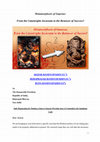
Convergence to Praxis, Once in a Blue Moon Academia, Sep 21, 2024
The sarcastic as well as satirical paper-letter is an in-depth examination of the evolution of Lo... more The sarcastic as well as satirical paper-letter is an in-depth examination of the evolution of Lord Gaṇeśa in Hindu traditions, addressing the contradictions between ancient texts and contemporary worship practices. The authors write to the President of India, calling for the cessation of Gaṇeśa worship, arguing that it contradicts the Sanātana Dharma. The paper traces Gaṇeśa’s transformation from an anti-god symbolizing obstacles and calamities to a revered deity associated with success. It critically analyzes historical, mythological, and socio-political shifts that contributed to this metamorphosis. The letter questions the legitimacy of modern Gaṇeśa worship, linking it to political and ideological agendas within India's current political landscape. Ultimately, it proposes halting this idol worship to align religious practices with the ancient Sanātana codes. The authors intentionally mask themselves as "Hindutvavadins" in order to expose the violent religious extremism of the Saffron Fascist forces and the utter fruitlessness of their agenda.
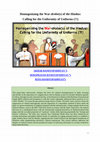
Convergence to Praxis, Once in a Blue Moon Academia, 2024
This paper-letter subversively critiques the drive for cultural homogenization in India, focusing... more This paper-letter subversively critiques the drive for cultural homogenization in India, focusing specifically on the imposition of a singular dress code for Hindus as part of a broader Hindutva agenda. It reflects, through sarcastic and satirical tools, on the historical evolution of the Rashtriya Swayamsevak Sangh (RSS) uniform and juxtaposes it with the varied, regionally influenced dress practices of socalled "Hindus" (?) across the geo-political imagination of India. The letter raises concerns about the suppression of cultural heterogeneity and the imposition of a monolithic standard of dress under the guise of a given normativity of religious (equated with the national) unity. Using examples from recent political debates, such as the RSS' shift from shorts to trousers and the hijab controversy, the authors advocate for a standardized dress code (by intentionally masking themselves as Hindutvavadins) that aligns with the so-called projection of "sanātana" values while rejecting purportedly the "foreign and Islamic" influences. The letter also explores how traditional Hindu dress has been influenced by colonial derivations and global fashion trends. It concludes by urging national leaders to establish a rigid, uniform dress code for Hindus, arguing that this would reinforce the ideological foundations of Hindutva while marginalizing alternative cultural expressions. This critical analysis addresses the dangers of cultural erasure and the paradoxical nature of enforcing uniformity in a society marked by deep-seated diversity.
Convergence to Praxis, Once in a Blue Moon Academia, 2022
This paper-letter strives to sarcastically subvert the perception of the second sex by the member... more This paper-letter strives to sarcastically subvert the perception of the second sex by the members of the Hindutva camp by applying the Brechtian theatrical method as well as the Derridian Militant Deconstruction. The paper-letter specifically focuses on the Durga Vahini, the female wing of the Sangh Parivar, by exposing the inner aporia or uncontradictory contradictions of the gendered, phallocentric Hindutva gaze.
Convergence to Praxis, Once in a Blue Moon Academia, 2022
License: CC BY 4.0; This paper-letter aims to sarcastically subvert the Hindutva perception of se... more License: CC BY 4.0; This paper-letter aims to sarcastically subvert the Hindutva perception of sexuality (act-pleasure-desire) in the context of Satyajit Ray’s depiction of the art of human intimacy. Though Hindutvavadins, the other Victorians, use the name of Ray for a film award, they even do not know the creative subtlety of Ray’s gaze. It is also to be noted that Ray himself had to change his representation of sexuality to accommodate the community standards of the Indian audience (Ray mentioned this type of constraint in many of his interviews). The colonized Hindutvavadins, are aping the Victorian standard of morality without keeping in mind the explicitly erotic temple architectures as well as sculptures spread throughout the South-Asian subcontinent.
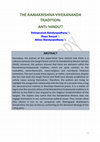
Convergence to Praxis, Once in a Blue Moon Academia, 2022
License: CC BY 4.0; Nowadays, the authors of this paper-letter have noticed that there is a collu... more License: CC BY 4.0; Nowadays, the authors of this paper-letter have noticed that there is a collusion between the Sangh Parivar and Sri Sri Ramakrishna Mission Ashram (RKM). However, the authors showed that there are elements within the Ramakrishna-Vivekananda tradition, which are quite contrary to the monolithic, mono-theocratic, mono-religious and non-liberal Hindutva extremism. This text reveals these aspects, or rather, contradictions, despite the fact that both the Sangh Parivar and RKM have already established an unholy nexus among themselves. Therefore, the authors are trying to highlight this antagonistic relationship with the help of a sarcastic tone, using the deconstructive method or Brechtian theatrical praxis. It is a matter of regret that the syncretic ethos of the Ramakrishna-Vivekananda tradition is in oblivion as the RKM is now trapped by the religious fundamentalism of the Sanghis. The readers may notice that the Ramakrishna Mission does not engage themselves in any controversial political issues. They remain silent (this silence is not to be compared with Dhanagopal Mukherjee's "Ramakrishna: the face of silence"), conforming to the dominant ideology of the ruling party.
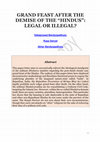
Convergence to Praxis, Once in a Blue Moon Academia, 2022
License: CC BY 4.0; This paper-letter, rather a mock-letter to the President of India, aims to sa... more License: CC BY 4.0; This paper-letter, rather a mock-letter to the President of India, aims to sarcastically subvert the ideological standpoint of the militant Hindutva mindset regarding the post-death rituals cum grand feast of the Hindus. The authors of this paper-letter have deployed deconstructive methodology and Brechtian theatrical praxis to expose the underlying plurality of the imagined nation-state called "India". In Rajasthan, India, the Rajasthan Prevention of Mrityu Bhoj Act (1960) legally prohibits such vulgar grand feast after death. On the other hand, the militant Hindutvavadins are for consolidating a Uniform Civil Code, targeting the Islamic law. However, within the so-called Hindutva domain itself, there are many varieties, pluralities, heterogeneities. This particular law shows that the banning is only deployable in the state of Rajasthan and other non-Rajasthani Hindus do not come under the purview of the same. The Sangh Parivar do not care about their own inconsistencies, though they carry out attacks on "other" religions for the sake of enforcing their idea of a uniform civil code.
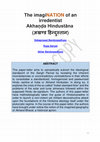
Convergence to Praxis, Once in a Blue Moon Academia, 2022
License: CC BY 4.0;
This paper-letter aims to sarcastically subvert the ideological standpoint ... more License: CC BY 4.0;
This paper-letter aims to sarcastically subvert the ideological standpoint of the Sangh Parivar by revealing the inherent inconsistencies or uncontradictory contradictions in their efforts to consolidate a standardized, homogenized and pasteurized Hindu rashtra of India or Akhand Hindustan. In doing so, it explores the crisis of the so-called “Indian standard time” and the problems of the solar and lunar almanacs followed within the supposed Hindu de-signatum. The authors of this paper-letter have methodologically taken the guise of Hindutvavadins in order to launch a non-violent yet militant deconstructive attack upon the foundations of the Hindutva ideology itself under the plutocratic regime. In the course of this paper-letter, the authors have brought under notice the notion of the imagined geography of Akhand Bharat, a historical a priori.
1998. “রাজনীতি ও নীতিতত্ত্বঃ মিশেল ফুকোর সঙ্গে একটি সাক্ষাৎকার”. Kolkata: Sur, Chiranjib ed. Aloc... more 1998. “রাজনীতি ও নীতিতত্ত্বঃ মিশেল ফুকোর সঙ্গে একটি সাক্ষাৎকার”. Kolkata: Sur, Chiranjib ed. Alochanachakra Collection-XI. (pp.158-165). RN. 69543/87.
Reviews, Discussion Papers by Rupa Sanyal
Convergence to Praxis, Once in a Blue Moon Academia, 2022
This paper-letter to the President of India et al., is seeking the legalization of active volunta... more This paper-letter to the President of India et al., is seeking the legalization of active voluntary euthanasia in India in the context of calamitous and cataclysmic socio-political-economic and environmental situation. This article shows, often sarcastically, that the religious extremist plutocratic regime has led to suicides, unhappiness, hunger, malnutrition, unemployment and so on. It also shows that the present government is following the blueprint of the Third Reich, especially in connection with the Aktion-T4 project. (License: CC BY 4.0)
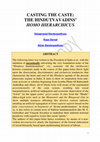
Convergence to Praxis, Once in a Blue Moon Academia, 2021
The following letter was written to the President of India et al., with the intention of sarcasti... more The following letter was written to the President of India et al., with the intention of sarcastically subverting the very foundation-stone of the "Hindutva fundamentalism", viz., casteism. All the (deliberate) heinous comments made in the course of this paper-letter throw light upon the dissociating, discriminatory and exclusivist tendencies that characterize the heart and soul of the Hindutva agenda of the present plutocratic regime in India. It aims to draw its inspiration from anti-caste activists or scholars beginning from Jyotiba Phule till Babasaheb Ambedkar and others, all of whom were well aware of the regimented governmentality of the caste system, resulting into social marginalization, political subjugation and economic deprivation of the "lower" (in the upper-castes' gaze) castes. It cites from the "Hindu" ethico-legal texts such as the Manusmrti and the Bhagavad Gita to show multiple instances affirming this divisive casteist outlook, entailing an artificial segregation of homo sapiens sapiens based on the false consciousness or hegemony of 'divine predestination'. In doing so, it also refers to certain texts of Saffron fundamentalists like M. S. Golwalkar and Vinayak Savarkar to underline their inherent notional paradoxes with regard to issues like racial "purity". The authors of this paper-letter hence scrutinize, by means of a non-violent deconstructive attack, the legitimacy of the formal elaboration of social hierarchy based upon unalternating division of labour.
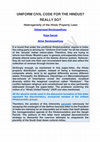
Convergence to Praxis, Once in a Blue Moon Academia, 2021
It is found that under the unofficial Hindutvavādins’ regime in India, the ruling party is strivi... more It is found that under the unofficial Hindutvavādins’ regime in India, the ruling party is striving for “Uniform Civil Code” for all the citizens of the ‘secular’ Indian nation-state. Therefore, they are trying to reform non-Hindu ‘Muslim Laws’ in general, and especially they have already altered some parts of the Islamic divorce system. However, they do not look into their own inconsistent laws that also affect the collection of revenue through income tax.
Strikingly enough, as mentioned in this paper-letter, the Hindu property distribution system, instead of being a homogeneous, composite whole, tend to be applied differently across different states. Principally, the Mitākṣarā, Dāyabhāga and Marumakkattayam law-schools of inheritance reveal the complicated, localized diversity within the imagined construct called “Hinduism”. The conflict between religious and constitutional law is also pertinently addressed through the paper-letter. The problems centering the notion of a “Hindu United Family” (HUF) are also mentioned.
All the abusive words used in the discursive formation of this letter represent the discriminatory, exclusivist mindset of the militant Hindutvavādin groups.
Therefore, the senders of this inherently sarcastic (obviously for escaping the onslaught of the Saffron fascists) letter to the President of India are claiming for an impossible set of tasks that itself defeats the homogenization agenda of the Hindutvavādins and the Sangh Parivār. The authors of this letter have adopted deconstructive strategy to dismantle the coercive attempts to singularize the plurality of the South East Asian cultural milieu.
Convergence to Praxis, Once in a Blue Moon Academia, 2021
This letter-paper questions the legitimacy of Article 371 of Indian Constitution after the revoki... more This letter-paper questions the legitimacy of Article 371 of Indian Constitution after the revoking of Article 370 by the Bharatiya Janata Party (5 August 2019). The paper traces the history of all the Indian federal States, which are listed in Article 371 with a special emphasis on Jammu and Kashmir.
License: CC BY 4.0
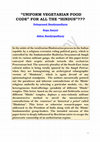
Convergence To Praxis, Once in a Blue Moon Academia, 2021
In the midst of the totalitarian Hinduization process in the Indian republic by a religious extre... more In the midst of the totalitarian Hinduization process in the Indian republic by a religious extremist ruling political party, which is controlled by the fundamentalist Rashtriya Swayamsevak Sangh with its various militant gangs, the authors of this paper-letter conveyed their sceptic attitude towards this exclusivist Procrustean bed. The syncretic plurality of the SouthEast Asian cultural milieu is being totally ignored by the Sangh Parivar, when they are homogenizing an archetypical ethnographic version of "Hinduism", which is again devoid of any epistemological standpoint. The authors sarcastically pointed out the paradoxes and inherent contradictions of the 'Hindu' religious umbrella by selecting a particular module, viz., the heterogeneous food-offerings (prasāda) of different "Hindu" temples. This letter, based on the surveys and fieldworks across different "Hindu" temples, deploys a non-violently militant deconstructive method to unveil the uncontradictory contradictions of the 'construct' or 'historical a priori' called "Hinduism". This letter or otherwise research-paper was addressed to the President of India along with all the 'Hindu' fundamentalist group-leaders. The intended sarcasm of this paper-letter is deeply influenced by Brechtian satire to escape the plutocratic censorship of an authoritarian regime.
Books by Rupa Sanyal
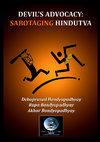
Convergence to Praxis, Once in a Blue Moon Academia, 2022
2022. License: CC by 4.0; In the course of confronting members of the Hindutvavadins’ ruling part... more 2022. License: CC by 4.0; In the course of confronting members of the Hindutvavadins’ ruling party in India, we have faced a great problem while conversing with the members of the Sangh Parivar. We were confused with a paradox: The Hindutvavadins do not know what Hindutva is. What are the distinctive features of the Hindutva as preached by the sangh parivar? This question has haunted us as there are many contradictory features within the exonym (the naming of other community by another other) The ruling party is trying to impose a phantasmic Hindutvavada as a legally codified ruling ideology for governing the nation state of India. It is needless to say that India is nothing more than a geo-political entity with variations or diversities. To legalize all these heterogeneities under one umbrella of “Hindutva” is a difficult task to pursue. Especially, in terms of the legal codification of Hindutva, i.e., it is a cherished (as indoctrinated by Hindutvavadins) yet impossible uniformity when it comes to the decision-making of the lawmakers. This book is an attempt to provide the counter-cultural tool to evolve an art of resistance against the all-pervading Saffron Fascism by exposing its inner contradictions across different modules such as caste, gender, food habits, regionalism, property distribution etc.








Uploads
LEXICAL/ENCYCLOPEDIC ENTRIES by Rupa Sanyal
Papers by Rupa Sanyal
This paper-letter aims to sarcastically subvert the ideological standpoint of the Sangh Parivar by revealing the inherent inconsistencies or uncontradictory contradictions in their efforts to consolidate a standardized, homogenized and pasteurized Hindu rashtra of India or Akhand Hindustan. In doing so, it explores the crisis of the so-called “Indian standard time” and the problems of the solar and lunar almanacs followed within the supposed Hindu de-signatum. The authors of this paper-letter have methodologically taken the guise of Hindutvavadins in order to launch a non-violent yet militant deconstructive attack upon the foundations of the Hindutva ideology itself under the plutocratic regime. In the course of this paper-letter, the authors have brought under notice the notion of the imagined geography of Akhand Bharat, a historical a priori.
Reviews, Discussion Papers by Rupa Sanyal
Strikingly enough, as mentioned in this paper-letter, the Hindu property distribution system, instead of being a homogeneous, composite whole, tend to be applied differently across different states. Principally, the Mitākṣarā, Dāyabhāga and Marumakkattayam law-schools of inheritance reveal the complicated, localized diversity within the imagined construct called “Hinduism”. The conflict between religious and constitutional law is also pertinently addressed through the paper-letter. The problems centering the notion of a “Hindu United Family” (HUF) are also mentioned.
All the abusive words used in the discursive formation of this letter represent the discriminatory, exclusivist mindset of the militant Hindutvavādin groups.
Therefore, the senders of this inherently sarcastic (obviously for escaping the onslaught of the Saffron fascists) letter to the President of India are claiming for an impossible set of tasks that itself defeats the homogenization agenda of the Hindutvavādins and the Sangh Parivār. The authors of this letter have adopted deconstructive strategy to dismantle the coercive attempts to singularize the plurality of the South East Asian cultural milieu.
License: CC BY 4.0
Books by Rupa Sanyal
This paper-letter aims to sarcastically subvert the ideological standpoint of the Sangh Parivar by revealing the inherent inconsistencies or uncontradictory contradictions in their efforts to consolidate a standardized, homogenized and pasteurized Hindu rashtra of India or Akhand Hindustan. In doing so, it explores the crisis of the so-called “Indian standard time” and the problems of the solar and lunar almanacs followed within the supposed Hindu de-signatum. The authors of this paper-letter have methodologically taken the guise of Hindutvavadins in order to launch a non-violent yet militant deconstructive attack upon the foundations of the Hindutva ideology itself under the plutocratic regime. In the course of this paper-letter, the authors have brought under notice the notion of the imagined geography of Akhand Bharat, a historical a priori.
Strikingly enough, as mentioned in this paper-letter, the Hindu property distribution system, instead of being a homogeneous, composite whole, tend to be applied differently across different states. Principally, the Mitākṣarā, Dāyabhāga and Marumakkattayam law-schools of inheritance reveal the complicated, localized diversity within the imagined construct called “Hinduism”. The conflict between religious and constitutional law is also pertinently addressed through the paper-letter. The problems centering the notion of a “Hindu United Family” (HUF) are also mentioned.
All the abusive words used in the discursive formation of this letter represent the discriminatory, exclusivist mindset of the militant Hindutvavādin groups.
Therefore, the senders of this inherently sarcastic (obviously for escaping the onslaught of the Saffron fascists) letter to the President of India are claiming for an impossible set of tasks that itself defeats the homogenization agenda of the Hindutvavādins and the Sangh Parivār. The authors of this letter have adopted deconstructive strategy to dismantle the coercive attempts to singularize the plurality of the South East Asian cultural milieu.
License: CC BY 4.0